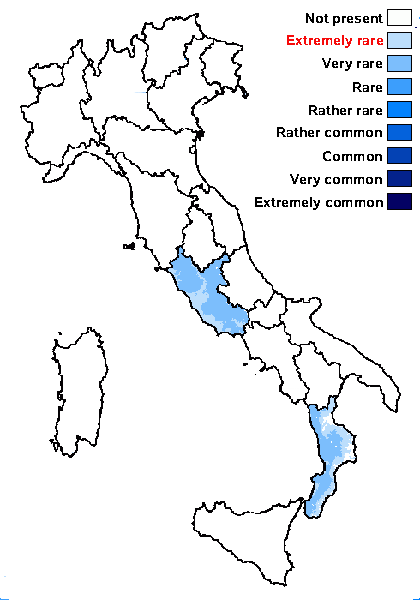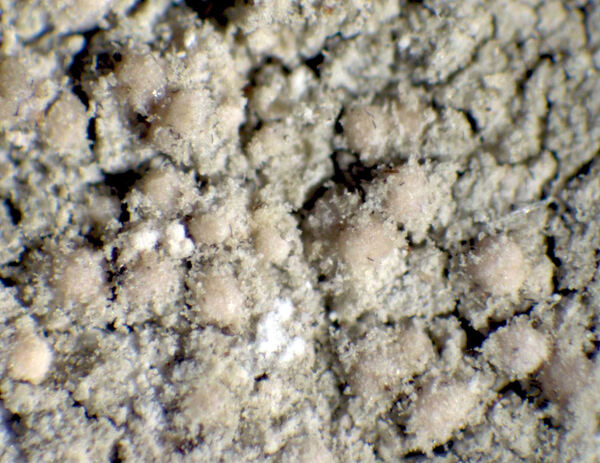Scoliciosporum pruinosum (P. James) Vězda
Folia Geobot. Phytotaxon., 13: 414, 1978. Basionym: Bacidia pruinosa P. James - Lichenologist, 5: 117, 1971.
Synonyms:
Distribution: N - VG. C - Tosc (Ravera & al. 2025b), Laz (TSB 17669). S - Cal (Puntillo 1996, Puntillo 2011).
Description: Thallus crustose-subleprose, thinly episubstratic, whitish, finely granulose, sometimes evanescent. Apothecia biatorine, 0.1-0.3(-0.4) mm across, whitish to pale pink-coloured when young, pale brown at the end, from the beginning strongly convex and immarginate, sometimes subglobose and tuberculate, often white-pruinose. Proper exciple very thin, of radiating, branched and anastomosing hyphae; epithecium colourless to pale yellowish brown, with a layer of yellowish granules dissolving in K; hymenium colourless, I+ blue; paraphyses strongly branched and anastomosing, immersed in a gelatinous matrix and resembling excipular hyphae, not swollen at apices. Asci 8-spored, cylindrical-clavate, with a K/I+ blue apical dome penetrated by a narrow, K/I- apical cushion surrounded by a narrow, deeply K/I+ blue zone, the wall K/I- but surrounded by a I+ red-brown and K/I+ blue outer layer, the ocular chamber small, Biatora-type. Ascospores indistinctly 3-5-septate, hyaline, (20-)22-35(-40) x 1-1.5(-2) µm strongly curved at least at one end, often S-shaped, spirally twisted in the asci. Photobiont chlorococcoid, the cells 7-15 µm wide. Spot tests: thallus K-, C-, KC-, P-, UV-; apothecia fleeting KC+ red, UV+ white. Chemistry: thallus without lichen substances; lobaric acid in the pruina of apothecia. Note: a mild-temperate species found on bark, especially of old oaks, usually on surfaces protected from rain, with optimum in humid deciduous, more rarely evergreen forests, often along rivers. Perhaps it does not belong to Scoliciosporum. It is included in the Italian red list of epiphytic lichens as “Endangered” (Nascimbene & al. 2013c).
Growth form: Crustose
Substrata: bark
Photobiont: green algae other than Trentepohlia
Reproductive strategy: mainly sexual
Most common in areas with a humid-warm climate (e.g. most of Tyrrenian Italy)
In underhangs rarely wetted by rain
Commonnes-rarity: (info)
Alpine belt: absent
Subalpine belt: absent
Oromediterranean belt: absent
Montane belt: very rare
Submediterranean belt: extremely rare
Padanian area: absent
Humid submediterranean belt: very rare
Humid mediterranean belt: extremely rare
Dry mediterranean belt: absent

Predictive model
Herbarium samples
Growth form: Crustose
Substrata: bark
Photobiont: green algae other than Trentepohlia
Reproductive strategy: mainly sexual
Most common in areas with a humid-warm climate (e.g. most of Tyrrenian Italy)
In underhangs rarely wetted by rain
Commonnes-rarity: (info)
Alpine belt: absent
Subalpine belt: absent
Oromediterranean belt: absent
Montane belt: very rare
Submediterranean belt: extremely rare
Padanian area: absent
Humid submediterranean belt: very rare
Humid mediterranean belt: extremely rare
Dry mediterranean belt: absent

Predictive model
| Herbarium samples |
 INDEX FUNGORUM
INDEX FUNGORUM
 GBIF
GBIF




